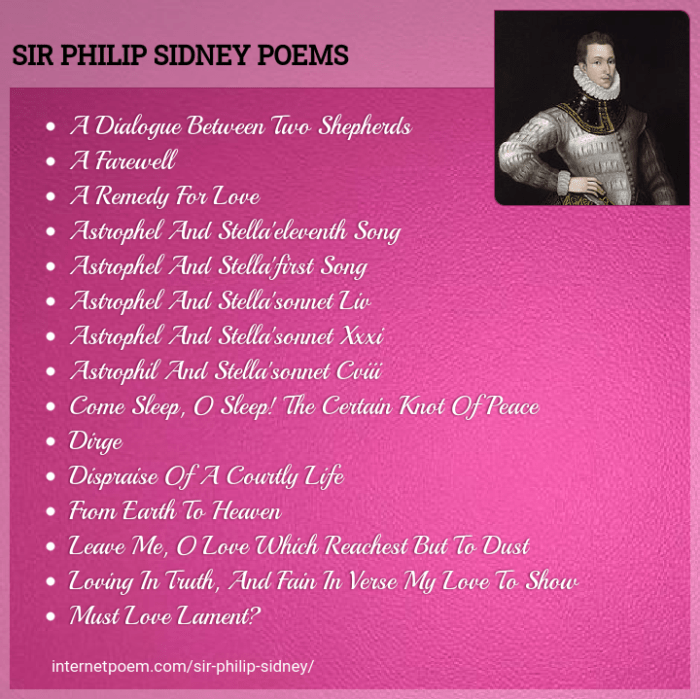Sonnet 39 sir philip sidney – Sonnet 39 by Sir Philip Sidney is a captivating masterpiece that has captivated readers for centuries. With its exquisite language, profound themes, and enduring relevance, this sonnet stands as a testament to the enduring power of love and beauty.
Delving into the intricate structure, literary devices, and historical context of Sonnet 39, we embark on a journey of discovery, uncovering the sonnet’s timeless appeal and its enduring significance in the literary landscape.
Sonnet 39 Overview
Sir Philip Sidney’s Sonnet 39 is a poignant exploration of unrequited love and the speaker’s inner turmoil. The sonnet is structured in the traditional Petrarchan form, consisting of an octave (eight lines) and a sestet (six lines), with a rhyme scheme of ABBAABBA CDECDE.
The octave presents the speaker’s hopeless love for a woman who remains indifferent to his affections. The speaker laments his unfulfilled desire, comparing himself to a ship lost at sea and a bird that cannot reach its destination. The sestet shifts to a more introspective tone, as the speaker reflects on the futility of his pursuit and the pain it has caused him.
Rhyme Scheme and Meter, Sonnet 39 sir philip sidney
The sonnet’s rhyme scheme and meter contribute to its musicality and emotional impact. The ABBAABBA rhyme scheme creates a sense of unity and closure in the octave, while the CDECDE rhyme scheme in the sestet provides a sense of resolution and finality.
The sonnet is written in iambic pentameter, with each line consisting of ten syllables arranged in five pairs of unstressed and stressed syllables. This rhythmic pattern creates a smooth and flowing cadence that enhances the sonnet’s lyrical qualities.
Literary Devices
Sir Philip Sidney’s Sonnet 39 employs various literary devices to enhance its meaning and impact. These devices create vivid imagery, draw comparisons, and personify abstract concepts, contributing to the sonnet’s exploration of love, beauty, and mortality.
Metaphors
The sonnet abounds with metaphors that compare the beloved to precious objects and natural phenomena. For instance, the speaker describes his love as “a jewel rich in worth,” suggesting her rarity and value. Another metaphor compares the beloved’s eyes to “heaven’s lights,” highlighting their brilliance and celestial beauty.
Similes
Sidney also uses similes to draw explicit comparisons between the beloved and other objects. In one line, he says, “Thy lips are like to rubies newly set,” emphasizing the redness and allure of her mouth. Another simile compares the beloved’s skin to “alabaster,” a white and translucent stone, conveying her purity and fairness.
Personification
The sonnet personifies abstract concepts to make them more relatable and impactful. For example, Sidney writes, “Time’s cruel hand hath made my lady old,” attributing human qualities to the relentless force of time. This personification highlights the destructive effects of time on beauty and youth.
The beauty of Sir Philip Sidney’s Sonnet 39 is like a señal de peatones en la via – a beacon of hope and guidance amidst the chaos. It offers a moment of respite, reminding us of the love and joy that can be found even in the most challenging times.
The sonnet’s poignant words, like the flashing lights of a pedestrian crossing, illuminate the path ahead, inspiring us to persevere and embrace the beauty that surrounds us.
Context and Historical Significance

Sonnet 39 was written during the Elizabethan era, a time of great cultural and social change in England. The Renaissance had brought a renewed interest in classical learning and culture, and this was reflected in the literature of the period.
Sonnet 39 is a typical example of the Elizabethan sonnet, with its Petrarchan form and its focus on love and beauty.
Sidney was one of the most important poets of the Elizabethan era, and his sonnets were widely admired and imitated. Sonnet 39 is one of his most famous sonnets, and it has been praised for its beauty and its insight into the nature of love.
Sonnet’s Place within Sidney’s Work
Sonnet 39 is one of the 154 sonnets that Sidney wrote to his beloved, Stella. The sonnets tell the story of Sidney’s love for Stella, and they explore the themes of love, beauty, and desire. Sonnet 39 is one of the most passionate sonnets in the sequence, and it expresses Sidney’s intense love for Stella.
Influence on Subsequent Poets
Sidney’s sonnets had a profound influence on subsequent poets, including William Shakespeare. Shakespeare’s sonnets often echo Sidney’s themes and language, and he even borrowed some of Sidney’s sonnets as models for his own work.
Interpretation and Analysis
Sonnet 39 by Sir Philip Sidney explores the complex and multifaceted nature of love, desire, and self-sacrifice. Through its use of vivid imagery, metaphorical language, and a carefully crafted structure, the sonnet conveys a profound message about the transformative power of love and the bittersweet nature of human relationships.
Imagery and Metaphor
The sonnet is replete with rich and evocative imagery, which helps to create a vivid and sensory experience for the reader. The opening lines, “Come sleep, O sleep, the certain knot of peace,” immediately evoke a sense of tranquility and respite from the turmoil of the waking world.
Sleep is personified as a “certain knot,” suggesting its ability to bind and secure the speaker’s troubled mind.
Throughout the sonnet, Sidney employs metaphors to explore the complex emotions associated with love. In line 7, he compares love to a “sea of care,” emphasizing its vastness and potentially overwhelming nature. The speaker’s desire for his beloved is likened to a “thousand deaths,” highlighting the intensity and consuming nature of his passion.
Structure and Form
The sonnet’s structure also plays a significant role in conveying its meaning. The traditional Petrarchan form, with its division into an octave (eight lines) and a sestet (six lines), allows Sidney to explore the different aspects of love in a balanced and organized manner.
The octave introduces the speaker’s longing for sleep and respite from the pain of love. The sestet shifts the focus to the transformative power of love, as the speaker realizes that his suffering is ultimately a source of joy and fulfillment.
Love as a Transformative Force
Ultimately, Sonnet 39 celebrates the transformative power of love. Through its ability to cause both pain and joy, love has the capacity to refine and elevate the human soul. The speaker’s initial desire for escape from love gradually gives way to an acceptance of its paradoxical nature.
In the final lines, the speaker declares that even in the midst of his suffering, he would not wish to be without the experience of love. This suggests that love, despite its inherent challenges, is an essential and ultimately rewarding aspect of human existence.
Comparison with Other Sonnets

Sonnet 39 by Sir Philip Sidney exhibits distinct characteristics that set it apart from other sonnets of the period. While sharing certain thematic and stylistic elements with other sonnets, it also possesses unique qualities that contribute to its individuality.
Similarities
- Theme of Love:Sonnet 39, like many sonnets of the period, explores the theme of love. Sidney expresses his deep affection for his beloved, describing the intense emotions and experiences associated with romantic love.
- Petrarchan Structure:The sonnet follows the traditional Petrarchan structure, consisting of an octave (eight lines) and a sestet (six lines), with a specific rhyme scheme.
- Figurative Language:Sidney employs vivid figurative language, including metaphors and similes, to convey his emotions and create a rich sensory experience for the reader.
Differences
- Personal and Emotional Focus:Sonnet 39 stands out for its intensely personal and emotional focus. Sidney delves deeply into his own feelings and experiences, expressing his vulnerability and longing in a raw and passionate manner.
- Absence of Petrarchan Idealization:Unlike many sonnets of the period that idealize the beloved, Sonnet 39 presents a more realistic and human portrayal of love. Sidney acknowledges the complexities and imperfections of his beloved, focusing on the genuine and intimate aspects of their relationship.
- Emphasis on the Speaker’s Inner Conflict:The sonnet explores the speaker’s inner conflict between his desire for love and his recognition of its potential for pain and sorrow. This introspective and self-reflective quality distinguishes Sonnet 39 from other sonnets that focus solely on the joys of love.
Modern Relevance: Sonnet 39 Sir Philip Sidney

Despite being written over four centuries ago, Sidney’s Sonnet 39 continues to resonate with modern readers, exploring timeless themes of love, beauty, and the fleeting nature of time.
Its exploration of the power of love to transcend physical beauty and the inevitability of aging finds echoes in contemporary discussions of self-acceptance, body positivity, and the search for meaningful connections in an increasingly digital world.
Love’s Enduring Power
In a society often preoccupied with physical appearance and youthfulness, Sidney’s sonnet reminds us of the enduring power of love that goes beyond superficial qualities.
- Sidney’s depiction of the speaker’s love as “more fair” than the “summer’s day” suggests that true love is not subject to the whims of time or the fading of beauty.
- The sonnet’s closing couplet, with its emphasis on love’s “eternal summer,” reinforces the idea that genuine love can withstand the passage of time and the inevitable changes that come with it.
FAQ Summary
What is the main theme of Sonnet 39?
Sonnet 39 explores the transformative power of love and its ability to inspire beauty and wonder.
How does Sidney use literary devices in Sonnet 39?
Sidney employs metaphors, similes, and personification to create vivid imagery and convey the emotional depth of the sonnet.
What is the historical context of Sonnet 39?
Sonnet 39 was written during the Elizabethan era, a period of great cultural and intellectual flourishing in England.
